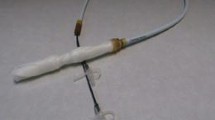Abstract
Introduction
The Ellipse intragastric balloon (EIGB) is a new swallowable balloon that does not require endoscopy at insertion or removal. The aim of this study is to investigate the safety of EIGB and its efficiency in weight reduction even after 1 year of expulsion.
Method
Prospective study on our initial experience with a consecutive group of patients who underwent the insertion of EIGB in the period between September 2016 and February 2017. The patients were followed up to assess pain, nausea, and vomiting after procedure. As well as, the time of balloon extraction, route of extraction, and weight loss.
Results
Total of 112 patients underwent EIGB placement. A 1-year follow-up was obtained on 85% of patients. Mean weight and BMI before the procedure 92.2 kg and 34.3 kg/m2, respectively. One patient had small bowel obstruction. Six patients did not tolerate EIGB and three patients had early deflation. Total weight loss % (TWL%) 10.7, 10.9, and 7.9% at 3, 6, and at date of last follow-up. When data were stratified according to BMI into two groups: group 1 (BMI 27.5–34.9) and group 2 (BMI 35–49), the TWL% for group 1 at 3 months, 6 months, and last day of follow-up are as follows: 10.2%, 10.6%, and 8.8%, while it was 11.5%, 11.2%, and 6.6% for group 2.
Conclusion
EIGB are effective, safe, and feasible non-invasive method for weight loss.




Similar content being viewed by others
References
Nunes GC, Pajecki D, de Melo ME, et al. Assessment of weight loss with the intragastric balloon in patients with different degrees of obesity. Surg Laparosc Endosc Percutan Tech. 2017;27(4):e83–e6.
Meshkinpour H, Hsu D, Farivar S. Effect of gastric bubble as a weight reduction device: a controlled, crossover study. Gastroenterology. 1988;95(3):589–92.
Machytka E, Chuttani R, Bojkova M, et al. Elipse, a procedureless gastric balloon for weight loss: a proof-of-concept pilot study. Obes Surg. 2016;26(3):512–6.
Jung F, Dietrich A, Stroh C, et al. Changes in attitudes towards bariatric surgery after 5 years in the German general public. Obes Surg. 2017;27(10):2754–8.
Stanford FC, Kyle TK, Claridy MD, et al. The influence of an individual’s weight perception on the acceptance of bariatric surgery. Obesity (Silver Spring). 2015;23(2):277–81.
Genco A, Dellepiane D, Baglio G, et al. Adjustable intragastric balloon vs non-adjustable intragastric balloon: case-control study on complications, tolerance, and efficacy. Obes Surg. 2013;23(7):953–8.
Genco A, Cipriano M, Materia A, et al. Laparoscopic sleeve gastrectomy versus intragastric balloon: a case-control study. Surg Endosc. 2009;23(8):1849–53.
Force ABET, Committee AT, Abu Dayyeh BK, et al. Endoscopic bariatric therapies. Gastrointest Endosc. 2015;81(5):1073–86.
Force ABET, Committee AT, Abu Dayyeh BK, et al. ASGE Bariatric Endoscopy Task Force systematic review and meta-analysis assessing the ASGE PIVI thresholds for adopting endoscopic bariatric therapies. Gastrointest Endosc. 2015;82(3):425–38. e5
Mathus-Vliegen EMH. Is endoscopy really necessary for placing intragastric balloons? Obes Surg. 2018;28(1):169–75.
Alsabah S, Al Haddad E, Ekrouf S, et al. The safety and efficacy of the procedureless intragastric balloon. Surg Obes Relat Dis. 2018;14(3):311–7.
Imaz I, Martínez-Cervell C, García-Álvarez EE, et al. Safety and effectiveness of the intragastric balloon for obesity. A meta-analysis. Obes Surg. 2008;18:841–6.
Author information
Authors and Affiliations
Corresponding author
Ethics declarations
Conflict of Interest
The authors declare that they have no conflict of interest.
Ethical Approval
Ethical approval for conducting the study was obtained from Kuwait University Ethical committee and Kuwait Ministry of Health.
Additional information
Publisher’s Note
Springer Nature remains neutral with regard to jurisdictional claims in published maps and institutional affiliations.
Rights and permissions
About this article
Cite this article
Jamal, M.H., Almutairi, R., Elabd, R. et al. The Safety and Efficacy of Procedureless Gastric Balloon: a Study Examining the Effect of Elipse Intragastric Balloon Safety, Short and Medium Term Effects on Weight Loss with 1-Year Follow-Up Post-removal. OBES SURG 29, 1236–1241 (2019). https://doi.org/10.1007/s11695-018-03671-w
Published:
Issue Date:
DOI: https://doi.org/10.1007/s11695-018-03671-w




